Table of Contents
Schadstoffe in der Kleidung? Das sollten alle Eltern wissen
This page may contain affiliate links. We may earn a commission on purchases, at no additional cost to you. Learn more →
Hast du dir schon einmal Gedanken darüber gemacht, was den ganzen Tag über die Haut deines Kindes berührt? Während du darauf achtest, nährstoffreiche Lebensmittel auszuwählen und sichere Spielzeuge zu kaufen, könnten Giftstoffe in der Kleidung die unsichtbare Gefahr in der Garderobe deines Kindes sein.
Die bittere Wahrheit ist: Viele unserer Alltagskleidungsstücke sind mit schädlichen Chemikalien belastet – von giftigen Farbstoffen bis hin zu gefährlichen Ausrüstungsmitteln. Das sind keine abstrakten Risiken, sondern Stoffe, die täglich direkt mit unserer Haut in Kontakt kommen und unsere Gesundheit sowie das Wohlbefinden unserer Kinder beeinträchtigen können. Aber wie kann so etwas überhaupt in Kinderkleidung vorkommen?
Als Eltern wollen wir nur das Beste für unsere Kinder. Die Gefahren synthetischer Stoffe zu erkennen, ist nicht nur wichtig – es ist entscheidend für ihre Gesundheit (und auch für unsere). In diesem Artikel decken wir die versteckten Schadstoffe in Alltagskleidung auf und zeigen dir, wie du dich und dein Kind vor diesen stillen Gefahren schützen kannst.
Verstehen, was Schadstoffe in der Kleidung bedeuten
Was ist giftige Kleidung?
Giftige Kleidung bezeichnet Kleidungsstücke, die aus synthetischen Materialien gefertigt oder mit Chemikalien behandelt wurden, die der menschlichen Gesundheit schaden können. Diese Stoffe mögen auf den ersten Blick harmlos wirken, enthalten jedoch oft Substanzen, die durch die Haut aufgenommen, eingeatmet oder sogar indirekt über Umweltkontamination aufgenommen werden können. Die zunehmende Verwendung synthetischer Fasern und chemischer Behandlungen in modernen Textilien macht dieses Thema immer relevanter.
Aber wie weit verbreitet ist dieses Problem, und warum sollte es dich interessieren? Das Verständnis der Verbreitung synthetischer Stoffe ist der erste Schritt, um sicherere Entscheidungen für dich und deine Familie zu treffen.
Synthetische Chemikalien und Stoffe
Wusstest du, dass über 60 % der weltweit produzierten Kleidung aus synthetischen Fasern wie Polyester, Nylon und Acryl besteht? Diese Materialien sind in der Modeindustrie weit verbreitet, da sie kostengünstig und langlebig sind. Doch ihre Nutzung birgt oft verborgene Risiken.
Eine Studie hat gezeigt, dass Phthalate, die in der Textilindustrie häufig als Weichmacher eingesetzt werden, in Konzentrationen von bis zu 33,42 µg/g in Kinderkleidung aus Polyester-, Nylon- und Spandex-Mischungen vorkommen. Diese Chemikalien stehen im Verdacht, das Hormonsystem zu stören und reproduktionstoxisch zu wirken.
Ein kurzer Überblick über die Geschichte synthetischer Materialien in der Mode
In der Mitte des 20. Jahrhunderts wurden synthetische Stoffe als kostengünstige und praktische Alternative zu natürlichen Fasern populär. Innovationen wie Polyester und Nylon revolutionierten die Modeindustrie, da sie Kleidung boten, die knitterfrei, pflegeleicht und widerstandsfähig gegen Einlaufen und Verblassen war.
Doch diese Bequemlichkeit hatte einen versteckten Preis. Zu dieser Zeit waren die langfristigen gesundheitlichen Auswirkungen dieser Materialien noch nicht vollständig bekannt. Heute beginnen wir, die Konsequenzen zu erkennen – besonders bei Kindern, deren sich entwickelnde Körper empfindlicher auf die möglichen Schadstoffe in diesen Stoffen reagieren.
Mit der zunehmenden Nutzung synthetischer Materialien griff die Modeindustrie häufig auf Herstellungsprozesse zurück, die den Einsatz potenziell schädlicher Chemikalien beinhalteten. Substanzen wie Phthalate und Formaldehyd, die zur Verbesserung der Stoffeigenschaften eingesetzt werden, können erhebliche Gesundheitsrisiken mit sich bringen.
Der Aufstieg von Ultra-Fast-Fashion-Marken hat das Problem weiter verschärft. Die Nachfrage nach günstiger, trendiger Kleidung hat zu einer verstärkten Produktion synthetischer Stoffe geführt. Dabei werden die Umwelt- und Gesundheitsauswirkungen oft ignoriert, da Geschwindigkeit und niedrige Kosten über die Sicherheit gestellt werden.
Die Lieferkette der Modeindustrie ist komplex und bietet zahlreiche Gelegenheiten, bei denen schädliche Chemikalien eingebracht werden können – von der Färbung und Veredelung bis hin zur Anwendung von fleckenabweisenden und knitterfreien Behandlungen.
Für uns als Verbraucher liegt die Herausforderung darin, giftige Kleidung zu erkennen und zu vermeiden.
Die versteckten Gefahren synthetischer Stoffe
Wenn du durch deinen Kleiderschrank gehst, fallen dir vielleicht Etiketten wie Polyester, Viskose oder Nylon auf. Diese synthetischen Stoffe sind mehr als nur Begriffe auf einem Label – sie können potenzielle Quellen schädlicher Chemikalien sein, die die Gesundheit deines Kindes beeinträchtigen könnten.
Häufige schädliche Stoffe, die du vermeiden solltest
Polyester
Polyester ist allgegenwärtig – von T-Shirts bis hin zu Schuluniformen. Es ist beliebt, weil es günstig und langlebig ist. Während der Produktion wird Polyester jedoch mit Chemikalien wie Antimon behandelt, das als Katalysator verwendet wird. Auch wenn Antimon im Endprodukt nicht immer in großen Mengen vorkommt, gibt es Bedenken hinsichtlich der Auswirkungen einer langfristigen Exposition gegenüber hohen Konzentrationen.
Zudem trägt Polyester zur Mikrofaserverschmutzung bei, wenn es gewaschen wird. Ein einziger Waschgang kann bis zu 200.000 Mikroplastikfasern ins Abwasser freisetzen. Diese Mikroplastikpartikel enthalten oft schädliche Zusätze wie Phthalate und Flammschutzmittel, die sich in Wasserlebewesen anreichern und letztlich in die Nahrungskette gelangen.
Viskose (Rayon)
Die Herstellung von Viskose beinhaltet gefährliche Chemikalien wie Kohlenstoffdisulfid, Natriumhydroxid und Schwefelsäure. Besonders problematisch ist Kohlenstoffdisulfid, da es mit neurologischen Schäden und Beeinträchtigungen der Fortpflanzung in Verbindung gebracht wird.
Acryl
Acrylstoffe werden aus Polyacrylnitril hergestellt, das von der US-Umweltschutzbehörde (EPA) als potenziell krebserregend eingestuft wird. Ähnlich wie Polyester setzen auch Acrylstoffe beim Waschen Mikroplastik frei und tragen so zur Umweltverschmutzung bei.
Nylon
Nylon wird häufig in Badebekleidung und Strumpfhosen verwendet. Seine Herstellung erfordert den Einsatz verschiedener Chemikalien und kann Lachgas freisetzen, ein starkes Treibhausgas. Obwohl Formaldehyd nicht in allen Nylonprodukten vorkommt, kann es, wenn es verwendet wird, zu juckender Haut führen. Außerdem tragen Nylonkleidungsstücke zur Mikrofaserverschmutzung bei, indem sie winzige Fasern freisetzen, die schädliche Substanzen transportieren können.
Acetat
Acetat und Triacetat sind chemisch verarbeitete Stoffe, die aus Holzfasern gewonnen werden. Bei der Herstellung werden Lösungsmittel eingesetzt, die Hautreizungen und allergische Reaktionen hervorrufen können. Obwohl diese Stoffe als weniger giftig gelten als vollständig synthetische Materialien, sind sie nicht biologisch abbaubar und tragen nach ihrer Entsorgung zur Umweltverschmutzung bei.
Spezielle Behandlungen von Stoffen
Es sind nicht nur die Stoffe selbst, die ein Risiko darstellen, sondern auch die zusätzlichen chemischen Behandlungen, die auf sie angewendet werden.
Diese Behandlungen werden häufig eingesetzt, um Stoffeigenschaften wie Wasserabweisung, Fleckenresistenz, Flammschutz oder Knitterfreiheit zu verbessern. Allerdings bringen sie eigene Gesundheits- und Umweltprobleme mit sich.
Hier sind einige der häufigsten und gefährlichsten Behandlungen, die auf Stoffe angewendet werden:
Knitterfreie und fleckenresistente Kleidung
Kleidung, die als knitterfrei oder fleckenresistent gekennzeichnet ist, enthält oft per- und polyfluorierte Alkylsubstanzen (PFAS). Diese Chemikalien werden für solche Behandlungen verwendet und können in Polyesterstoffen in Konzentrationen von bis zu 193 ng/g nachgewiesen werden.
Die Exposition gegenüber PFAS wird mit der Unterdrückung des Immunsystems, Krebs und reproduktiven Schäden in Verbindung gebracht. Diese Stoffe werden oft als „ewige Chemikalien“ bezeichnet, da sie in der Umwelt nicht abgebaut werden und sich im Laufe der Zeit in Menschen und Wildtieren anreichern können.
Flammschutzmittel
Flammschutzmittel, insbesondere organophosphorhaltige Flammschutzmittel (OPFRs), werden häufig in der Kinder-Schlafbekleidung verwendet, um den Brandschutz zu gewährleisten. Diese Chemikalien können über die Haut aufgenommen werden und stehen im Verdacht, hormonelle Störungen, Entwicklungsprobleme und Neurotoxizität zu verursachen.
Wasserdichte Stoffe
Wasserdichte und wasserabweisende Stoffe enthalten oft perfluorierte Chemikalien (PFCs), die zur größeren Familie der PFAS gehören. Diese Chemikalien können mit der Zeit ausdünsten oder in die Umwelt gelangen, was zu einer Aufnahme durch Einatmen oder über die Haut führen kann.
PFCs werden mit verschiedenen Gesundheitsproblemen in Verbindung gebracht, darunter Leberschäden, Schilddrüsenerkrankungen, verminderte Fruchtbarkeit, Entwicklungsstörungen bei Kindern und bestimmten Krebsarten.
Antimikrobielle Behandlungen
Antimikrobielle Mittel werden in Stoffe integriert, um das Wachstum von Bakterien und unangenehme Gerüche zu hemmen. Sie finden sich häufig in Sportbekleidung und Krankenhaus-Textilien. Einige dieser Mittel enthalten giftige Chemikalien wie Triclosan oder Silber-Nanopartikel. Diese Stoffe können das hormonelle Gleichgewicht stören und zur Entwicklung von Antibiotikaresistenzen beitragen.
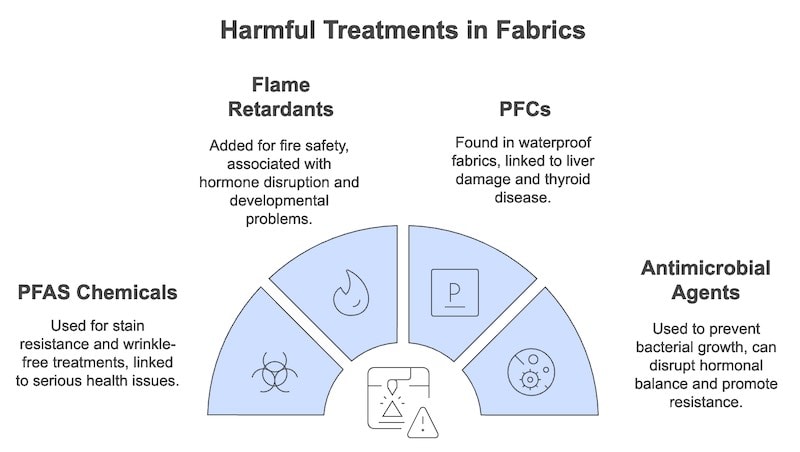
Lass uns einen schnellen Überblick über die stärksten und schädlichsten Giftstoffe schaffen, die häufig in Kleidung und Stoffen vorkommen.
Die gefährlichsten Chemikalien in Kleidung
Das Verständnis der spezifischen Chemikalien, die in Kleidung verborgen sind, kann dir helfen, sicherere Entscheidungen für deine Familie zu treffen. Hier ist eine Übersicht der gefährlichsten Substanzen, die häufig in Textilien nachgewiesen werden:
Phthalate
Verwendung: Als Weichmacher in synthetischen Stoffen wie Polyester, um diese flexibler zu machen.
Gesundheitsrisiken: Hormonelle Störungen, Fortpflanzungsprobleme, Entwicklungsstörungen und erhöhtes Krebsrisiko.
Bisphenole (BPA und BPS)
Verwendung: Zur Verbesserung der Flexibilität und Haltbarkeit von synthetischen Textilien.
Gesundheitsrisiken: Hormonelle Ungleichgewichte, Schäden an der Fortpflanzung sowie ein erhöhtes Risiko für Erkrankungen wie Brustkrebs.
Formaldehyd
Verwendung: Zur Behandlung von Stoffen, um sie knitterfrei zu machen.
Gesundheitsrisiken: Hautreizungen, Atemwegsprobleme und von der IARC als wahrscheinlich krebserregend für den Menschen eingestuft.
Per- und Polyfluoralkylsubstanzen (PFAS)
Verwendung: Für wasserabweisende, fleckenresistente und knitterfreie Kleidung.
Gesundheitsrisiken: Unterdrückung des Immunsystems, Leberschäden, Entwicklungsstörungen und bestimmte Krebsarten.
Azofarbstoffe
Verwendung: Zur Färbung von Textilien aufgrund ihrer leuchtenden Farben.
Gesundheitsrisiken: Können sich in aromatische Amine zersetzen, die krebserregend sind. Werden mit Hautreizungen und einem erhöhten Risiko für Blasenkrebs in Verbindung gebracht.
Giftige (schwere) Metalle (Blei, Chrom, Kobalt)
Verwendung: In Farbstoffen und Veredelungen von Textilien.
Gesundheitsrisiken: Hautreizungen, allergische Reaktionen, Organschäden und ein erhöhtes Krebsrisiko.
Tributylphosphat (TBP)
Verwendung: Als Flammschutzmittel oder Weichmacher in Kleidungsstoffen.
Gesundheitsrisiken: Hautreizungen und Atemwegsprobleme bei längerer Einatmung.
Dimethylfumarat (DMF)
Verwendung: Als Anti-Schimmelmittel bei der Lagerung oder dem Versand von Kleidung.
Gesundheitsrisiken: Verursacht schwere Hautreaktionen wie Dermatitis; in vielen Ländern aufgrund seiner Toxizität verboten.
Nonylphenolethoxylate (NPEs)
Verwendung: Als Tenside während der Textilverarbeitung eingesetzt.
Gesundheitsrisiken: Stören die endokrine Funktion, sind umweltpersistent und reichern sich in aquatischen Organismen an.
Organophosphat-Flammschutzmittel (OPFRs)
Verwendung: Werden Textilien hinzugefügt, um sie flammenresistent zu machen.
Gesundheitsrisiken: Neurotoxizität, hormonelle Störungen und Entwicklungsprobleme bei Kindern.
Neuere Generation von PFAS
Während ältere PFAS-Typen aufgrund ihrer Toxizität zunehmend aus dem Verkehr gezogen werden, werden in vielen Textilien inzwischen neue Generationen von PFAS-Verbindungen als Alternativen eingesetzt. Leider könnten diese neuen Verbindungen nicht sicherer sein als ihre Vorgänger.
Neue Forschungen zeigen, dass auch die neueren PFAS erhebliche Risiken für die menschliche Gesundheit und die Umwelt bergen, da sie persistent und bioakkumulativ sind. Deshalb können selbst Kleidungsstücke, die als „PFC-frei“ gekennzeichnet sind, andere schädliche perfluorierte Verbindungen enthalten.
Menschen reagieren unterschiedlich auf toxische Chemikalien in Kleidung. Insbesondere Personen mit Erkrankungen wie multipler chemischer Sensitivität (MCS) können bereits auf niedrige Expositionslevel durch synthetische Stoffe oder behandelte Kleidungsstücke empfindlich reagieren.
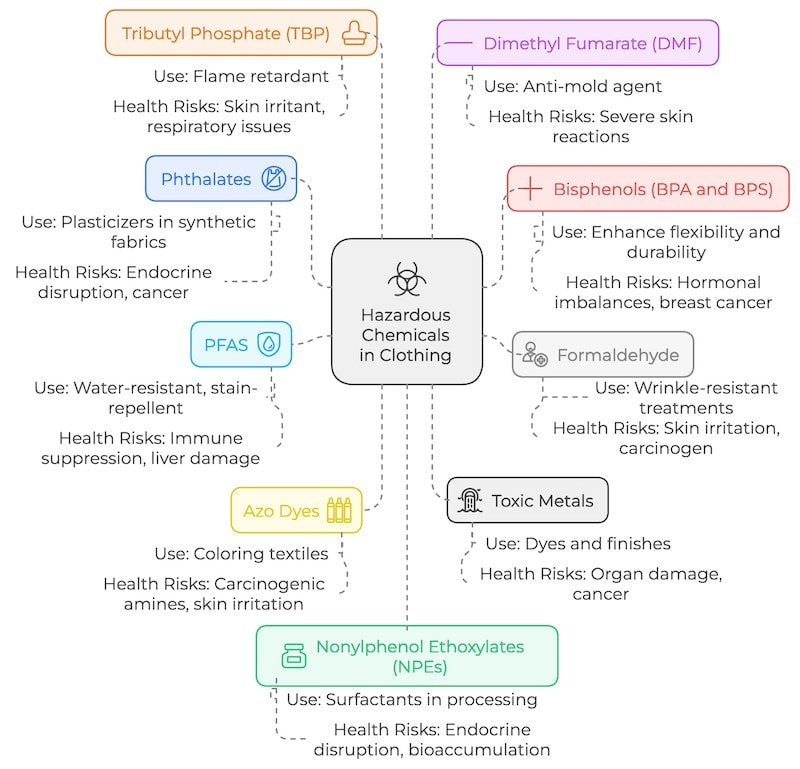
Wie Chemikalien in den Körper gelangen
Hautabsorption
Deine Haut ist ein lebendiges Organ, das Substanzen aufnimmt, mit denen es in Kontakt kommt. Chemikalien wie Phthalate und Bisphenole, die häufig in synthetischen Stoffen vorkommen, können besonders beim Schwitzen allmählich durch die Haut aufgenommen werden.
Ausgasung
Hast du schon einmal den „Neu-Kleider“-Geruch bemerkt? Dieser entsteht oft durch flüchtige organische Verbindungen (VOCs), die von synthetischen Materialien oder chemischen Behandlungen freigesetzt werden. Diese Gase können eingeatmet werden und potenziell Atemprobleme, Kopfschmerzen, Schwindel und langfristige Gesundheitsprobleme wie Leber- oder Nierenschäden verursachen.
Mikrofaserverschmutzung
Beim Waschen synthetischer Kleidung werden Mikroplastikfasern in Wassersysteme (und unser Trinkwasser) freigesetzt. Diese Fasern enthalten giftige Zusatzstoffe wie Phthalate und Flammschutzmittel, die sich in Meereslebewesen anreichern und schließlich über die Nahrungskette zu uns zurückkehren.
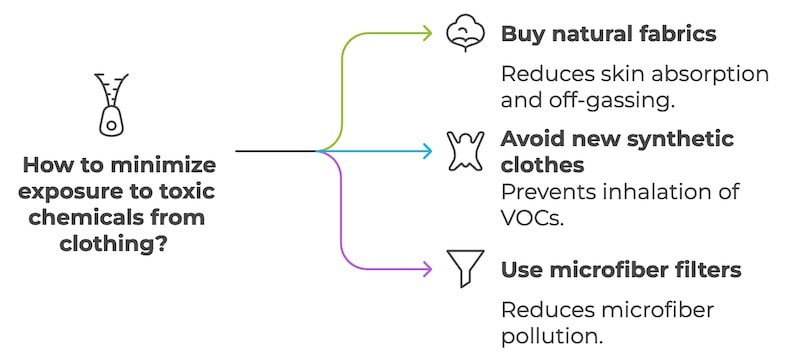
Warum Kinder besonders gefährdet sind
Kinder sind keine kleinen Erwachsenen – ihre Körper befinden sich noch in der Entwicklung. Dieses kontinuierliche Wachstum macht sie besonders anfällig für Giftstoffe.
Entwicklung von Körper und Systemen
Die Haut von Kindern nimmt Substanzen schneller auf, und ihre Entgiftungssysteme sind weniger effizient als die von Erwachsenen. Hier ist der Grund:
Dünnere Haut: Die Haut deines Kindes ist dünner und durchlässiger als deine. Dadurch können Substanzen leichter hindurchdringen, und Chemikalien aus Stoffen gelangen schneller in den Blutkreislauf.
Unreife Entgiftungssysteme: Leber und Nieren, die für die Filterung von Giftstoffen verantwortlich sind, sind bei Kindern noch nicht vollständig entwickelt. Dadurch fällt es ihrem Körper schwerer, schädliche Substanzen effizient auszuscheiden.
Rasches Wachstum: Während des Wachstums teilen und entwickeln sich die Zellen deines Kindes schnell. Eine Exposition gegenüber Giftstoffen in dieser entscheidenden Phase kann die normale Entwicklung stören und möglicherweise langfristige Gesundheitsprobleme verursachen.
Im Laufe der Zeit kann dies zu einer Ansammlung von Giftstoffen führen, deren Auswirkungen auf die Gesundheit wir erst zu verstehen beginnen.
Verhaltensbedingte Faktoren
Kinder bleiben Kinder – und genau das macht sie so einzigartig. Doch einige typische Verhaltensweisen im Kindesalter können ihre Exposition gegenüber schädlichen Chemikalien erhöhen:
Alles in den Mund nehmen: Babys und Kleinkinder erkunden die Welt mit dem Mund. Das Kauen an Ärmeln, Decken oder Spielzeug aus synthetischen Materialien kann dazu führen, dass Giftstoffe direkt in ihren Körper gelangen.
Spielen auf dem Boden: Kinder verbringen viel Zeit damit, auf Böden zu krabbeln und zu spielen, wo sich Staub und Mikrofasern aus synthetischer Kleidung ansammeln. Diese können eingeatmet oder verschluckt werden.
Diese Verhaltensweisen sind völlig natürlich und wichtig für ihre Entwicklung. Ziel ist es nicht, das Spielverhalten zu ändern, sondern sicherzustellen, dass ihre Umgebung – einschließlich ihrer Kleidung – so sicher wie möglich ist.

Fallstudien und Forschungsergebnisse
Phthalate in Kinderkleidung
Eine Studie, die im Journal of Environmental Science veröffentlicht wurde, zeigt, dass Kinder höhere Konzentrationen von Phthalaten in ihrem Körper aufweisen als Erwachsene. Ein Grund dafür ist die Exposition durch Kleidung. Phthalate können über die Haut aufgenommen oder durch ausgasende Materialien eingeatmet werden. Diese Chemikalien stehen im Verdacht, Entwicklungsprobleme wie Störungen des Autismus-Spektrums und andere neurodevelopmentale Verzögerungen zu verursachen. Darüber hinaus werden Phthalate mit reproduktiven Problemen und hormonellen Ungleichgewichten in Verbindung gebracht.
Endokrin wirksame Chemikalien
Eine Studie, veröffentlicht vom National Center for Biotechnology Information (NCBI), beleuchtet die erheblichen Auswirkungen endokrin wirksamer Chemikalien (EDCs) auf die Gesundheit von Kindern (Englisch). EDCs, die in vielen synthetischen Stoffen und Textilveredelungen vorkommen, können die Hormonfunktion stören, insbesondere während kritischer Entwicklungsphasen. Die Exposition gegenüber EDCs wurde mit Schilddrüsenerkrankungen, Fettleibigkeit, Diabetes und veränderter Produktion von Nebennierenhormonen bei Kindern in Verbindung gebracht. Diese Chemikalien finden sich häufig in Kleidung, die mit Flammschutzmitteln, wasserabweisenden Beschichtungen oder Weichmachern wie Phthalaten behandelt wurde.
Pestizidrückstände in Naturfasern
Selbst Naturfasern wie Baumwolle können Risiken bergen, wenn sie nicht biologisch angebaut werden. Konventionelle Baumwolle wird häufig während des Anbaus mit Pestiziden behandelt, die Rückstände im fertigen Stoff hinterlassen können. Die Exposition gegenüber Pestiziden wurde mit verschiedenen Gesundheitsproblemen bei Kindern in Verbindung gebracht, darunter Entwicklungsverzögerungen, Störungen des Immunsystems und ein erhöhtes Krebsrisiko.
Der renommierte Experte für Umweltgesundheit, Dr. Philip J. Landrigan, Kinderarzt und Epidemiologe, betont:
„Kinder sind aufgrund ihrer sich entwickelnden Systeme und Verhaltensweisen besonders anfällig für Umweltgifte. Die Reduzierung ihrer Exposition gegenüber schädlichen Chemikalien ist entscheidend, um ihre Gesundheit zu schützen.“
Sichere und nachhaltige Alternativen
Angesichts der zunehmenden Besorgnis über giftige Chemikalien in Kleidung ist es beruhigend zu wissen, dass es sicherere und nachhaltigere Alternativen gibt. Hier sind einige natürliche Stoffe, die nicht nur sanft zur Haut von dir und deinem Kind sind, sondern auch umweltfreundlich und frei von schädlichen Substanzen:
Bio-Baumwolle
Warum es sicher ist: Bio-Baumwolle wird ohne synthetische Pestizide oder Düngemittel angebaut. Dadurch kommen weniger schädliche Chemikalien mit der empfindlichen Haut deines Kindes in Kontakt.
Gesundheitliche Vorteile: Bio-Baumwolle ist weich, atmungsaktiv und hypoallergen – ideal für empfindliche Haut. Sie verringert das Risiko von Reizungen und allergischen Reaktionen, die durch chemische Rückstände in herkömmlicher Baumwolle verursacht werden können.
Nachhaltigkeit: Durch den Verzicht auf schädliche Chemikalien fördert der Anbau von Bio-Baumwolle gesündere Böden und benötigt weniger Wasser. Ein Gewinn für dein Kind und die Umwelt.
Bambusstoff
Warum es sicher ist: Wird Bambusstoff umweltfreundlich verarbeitet, behält er seine natürlichen Eigenschaften ohne den Einsatz aggressiver Chemikalien.
Gesundheitliche Vorteile: Unglaublich weich und atmungsaktiv. Bambusstoff ist hypoallergen und verfügt über natürliche feuchtigkeitsableitende Eigenschaften, was ihn ideal für Kinder mit empfindlicher Haut oder Allergien macht.
Nachhaltigkeit: Bambus wächst schnell, ohne Pestizide oder übermäßigen Wasserverbrauch. Damit gehört er zu den nachhaltigsten Stoffoptionen und ist eine ausgezeichnete Wahl für umweltbewusste Familien.
Leinen und Hanf
Warum sie sicher sind: Leinen und Hanf sind natürliche Fasern, die nur minimal chemisch behandelt werden müssen. Sie werden häufig mit wenig bis gar keinen Pestiziden angebaut, wodurch schädliche Rückstände reduziert werden.
Gesundheitliche Vorteile: Diese Stoffe sind atmungsaktiv und regulieren die Körpertemperatur—sie halten dein Kind im Sommer kühl und im Winter warm. Außerdem sind sie von Natur aus resistent gegen Bakterien und Schimmel.
Nachhaltigkeit: Leinen und Hanf benötigen weniger Wasser und gedeihen auch auf nährstoffarmen Böden. Besonders Hanf ist dafür bekannt, die Bodenqualität zu verbessern, was diese Stoffe zu umweltfreundlichen Alternativen macht.
Wolle und Seide
Warum sie sicher sind: Ethisch gewonnen sind Wolle und Seide frei von schädlichen chemischen Behandlungen. Diese natürlichen Fasern haben sich über Jahrhunderte bewährt.
Gesundheitliche Vorteile: Wolle ist ein hervorragender Isolator, der Kinder in kaltem Wetter warm hält, während sie gleichzeitig atmungsaktiv bleibt. Seide ist sanft und beruhigend—ideal für Babys oder Kinder mit Ekzemen oder empfindlicher Haut.
Nachhaltigkeit: Wolle und Seide sind erneuerbare und biologisch abbaubare Materialien, wenn sie verantwortungsvoll produziert werden. Mit Optionen wie Bio-Wolle oder Peace Silk wird nicht nur das Tierwohl, sondern auch der Umweltschutz unterstützt.
Tencel (Lyocell) und Modal
Warum sie sicher sind: Diese Stoffe werden aus nachhaltig gewonnenem Holz hergestellt und in einem umweltfreundlichen Kreislaufverfahren produziert, das Wasser und Lösungsmittel recycelt.
Gesundheitliche Vorteile: Tencel und Modal sind geschmeidig, atmungsaktiv und sanft zu empfindlicher Haut. Ihre hervorragenden feuchtigkeitsableitenden Eigenschaften sorgen dafür, dass aktive Kinder den ganzen Tag über trocken und bequem bleiben.
Nachhaltigkeit: Die Herstellung dieser Stoffe reduziert den Wasserverbrauch und die chemischen Abfälle im Vergleich zu herkömmlichen Verfahren erheblich. Sie sind eine kluge Wahl für die Gesundheit und die Umwelt.
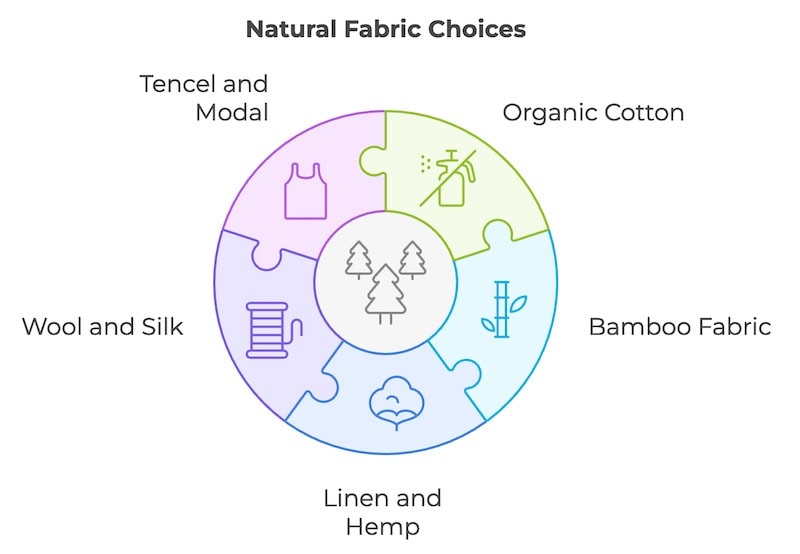
Tipps für Eltern: Der Wechsel zu sicherer Kleidung
Der Umstieg auf sichere und nachhaltige Kleidung für dein Kind mag zunächst nach einer großen Herausforderung klingen, muss es aber nicht sein. Mit ein paar praktischen Schritten kannst du ganz einfach zu gesünderen Alternativen wechseln. So gelingt der Einstieg:
Beginne mit den wichtigsten Kleidungsstücken
Tausche zunächst Kleidungsstücke aus, die direkt auf der Haut getragen werden, wie Unterwäsche und Schlafanzüge. Da diese einen besonders langen Hautkontakt haben, können sie einen großen Unterschied machen.
Denke auch darüber nach, Alltagskleidung wie T-Shirts, Leggings und Socken durch Varianten aus sicheren, natürlichen Materialien zu ersetzen.
Budgetfreundliche Strategien
Der Umstieg auf sicherere Kleidung muss nicht teuer sein. Es gibt viele Möglichkeiten, um umweltfreundliche Entscheidungen kostengünstiger zu gestalten.
Second-Hand shoppen
Second-Hand-Läden: Gebrauchte Kleidung ist nicht nur budgetfreundlich, sondern wurde oft schon mehrmals gewaschen, wodurch chemische Rückstände reduziert werden. In solchen Läden kannst du hochwertige Kleidungsstücke aus Naturfasern zu einem Bruchteil des Neupreises finden.
Online-Marktplätze: Webseiten und Apps, die sich auf Second-Hand-Artikel spezialisiert haben, ermöglichen es dir, bequem von zu Hause aus das zu finden, was du brauchst.
Setze auf Qualität statt Quantität
Weniger, aber hochwertiger: Hochwertige Kleidungsstücke sind langfristig oft kostengünstiger und gleichzeitig besser für die Gesundheit deines Kindes.
Wähle langlebige Stoffe: Naturfasern wie Bio-Baumwolle, Hanf und Leinen sind oft robuster als synthetische Materialien. Gut verarbeitete Kleidung hält selbst den wilden Abenteuern im Kinderalltag stand.
Vielseitige Basics: Setze auf neutrale Farben und zeitlose Schnitte, die sich leicht kombinieren lassen. So benötigt dein Kind weniger Kleidungsstücke und kann jedes Teil optimal nutzen.
Unterstütze ethische Marken
Wenn möglich, entscheide dich für Unternehmen, die Sicherheit, Nachhaltigkeit und ethische Produktionspraktiken in den Vordergrund stellen.
Recherchiere Marken
Achte darauf, wie transparent Unternehmen bei der Beschaffung ihrer Materialien und der Herstellung ihrer Produkte sind. Marken, die diese Informationen offen teilen, sind oft vertrauenswürdiger.
Zertifizierungen, auf die du achten solltest:
Nachhaltigkeitszertifikate wie GOTS (Global Organic Textile Standard) und OEKO-TEX Standard 100 zeigen, dass die Stoffe strengen Sicherheits- und Umweltstandards entsprechen.
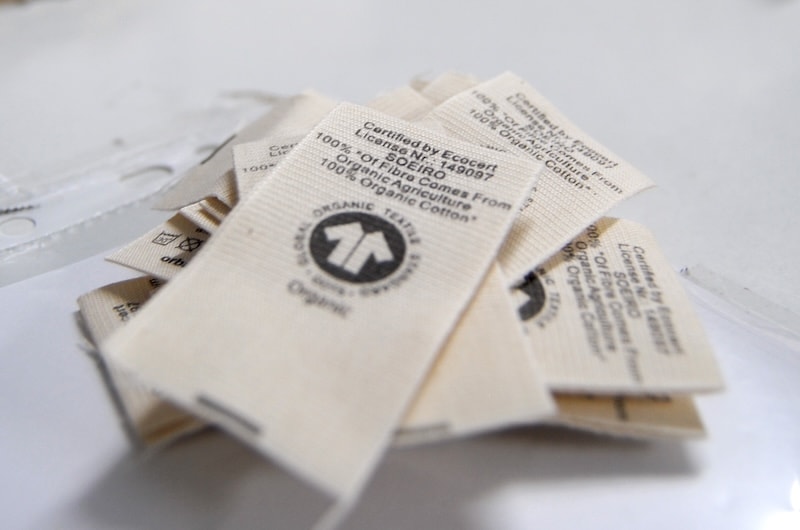
Denke daran, dass jeder kleine Schritt zählt. Du musst nicht alles auf einmal ändern. Selbst kleine Anpassungen können einen großen Unterschied für die Gesundheit deines Kindes und die Umwelt machen. Ob es darum geht, Etiketten genauer zu prüfen, auf organische Materialien zu setzen oder Marken zu unterstützen, die deine Werte teilen – du hast die Möglichkeit, etwas zu bewirken.
Nächste Schritte:
• Starte heute: Wähle einen der oben genannten Tipps und setze ihn diese Woche um.
• Teile deine Erfahrungen: Erzähle anderen Eltern von deinen Veränderungen. Vielleicht inspirierst du sie dazu, ebenfalls etwas zu ändern.
• Bleib informiert: Lerne weiterhin über nachhaltige Praktiken und Produkte. Je mehr du weißt, desto bessere Entscheidungen kannst du treffen.
Weitere Informationen
Bücher
"Make Fashion Better: Mit Stil die Welt verbessern" von Sarah Klymkiw* – Dieses Buch beleuchtet die Bedeutung von nachhaltiger Mode, bietet wertvolle Einblicke in Alternativen zu schadstoffbelasteter Kleidung und enthält DIY-Tips.
"Fashion Changers - Wie wir mit fairer Mode die Welt verändern können" von Jana Braumüller, Vreni Jäckle und Nina Lorenzen* – Der Guide für faire Mode bietet umfassende Einblicke in nachhaltige und ökologische Mode, zeigt inspirierende Wege zu einem faireren Kleiderschrank und stellt Labels, Menschen und Tipps vor, die die Modeindustrie verantwortungsvoller gestalten.
Webseiten und Blogs
Die Environmental Working Group (EWG) bietet hilfreiche Ressourcen zu schädlichen Chemikalien in Alltagsprodukten, einschließlich Kleidung. Ihre Website ist eine zuverlässige Quelle, um zu verstehen, welche Chemikalien vermieden werden sollten.
Good On You – Diese Website bewertet Modemarken basierend auf deren Nachhaltigkeits- und ethischen Praktiken. Sie ist eine hervorragende Ressource, um Marken zu finden, die auf schädliche Chemikalien verzichten und umweltfreundliche Materialien verwenden.
Fashion Revolution – Eine globale Bewegung, die sich für Transparenz in der Modeindustrie einsetzt. Ihr Blog behandelt Themen wie schädliche Chemikalien in Kleidung und fördert nachhaltige Alternativen.
Wenn dir dieser Beitrag gefallen hat, schau dir auch diese weiteren Artikel an:
Nachhaltige Sportbekleidung ohne Schadstoffe: die Besten Marken für Gesundes Training
Die 7 besten nachhaltigen Sport-BHs für ein gesünderes Workout
Wie Du PFAS in Kosmetik vermeidest: Dein Ratgeber für sichere Beauty-Produkte

FAQ's
Sind alle synthetischen Stoffe schädlich?
Nicht alle synthetischen Stoffe sind gleichermaßen schädlich, aber viele enthalten Chemikalien, die von der Haut aufgenommen oder in die Umwelt freigesetzt werden können. Es ist sinnvoll, sich über spezifische Materialien zu informieren und, wenn möglich, auf natürliche Fasern zurückzugreifen.
Wie erkennt man Schadstoffe in Kleidung?
Überprüfe das Etikett auf Materialien wie Polyester, Nylon, Acryl und chemische Behandlungen wie Flammschutzmittel. Zertifikate wie GOTS (Global Organic Textile Standard) oder OEKO-TEX können dir dabei helfen, die Sicherheit der Stoffe zu gewährleisten.
Kann man Giftstoffe aus Kleidung waschen?
Durch Waschen können einige oberflächliche Chemikalien entfernt werden, jedoch nicht die tief in den Fasern eingebetteten Schadstoffe. Zudem setzt das Waschen synthetischer Stoffe Mikroplastik in die Gewässer frei.
Welche Zertifizierungen gewährleisten die Sicherheit von Textilien?
Achte auf Zertifizierungen wie GOTS (Global Organic Textile Standard) und OEKO-TEX Standard 100. Diese zeigen, dass der Stoff strengen Sicherheits- und Umweltkriterien entspricht.
Wie erkenne ich PFAS in Kleidung?
Synthetische Stoffe wie Polyester, Nylon und Spandex werden häufig mit PFAS-basierten Beschichtungen behandelt. Kleidung, die als "wasserabweisend", "fleckenabweisend", "knitterfrei" oder mit "dauerhaft wasserabweisender (DWR)" Ausrüstung gekennzeichnet ist, enthält höchstwahrscheinlich PFAS. Solche Behandlungen finden sich oft bei Outdoor-Bekleidung wie Wanderhosen, Jacken und Sportbekleidung, um die Funktionalität zu verbessern.
Haftungsausschluss: Dieser Artikel dient ausschließlich Informationszwecken. Bitte konsultiere Fachleute für spezifische Ratschläge, die auf deine persönliche Situation zugeschnitten sind.













